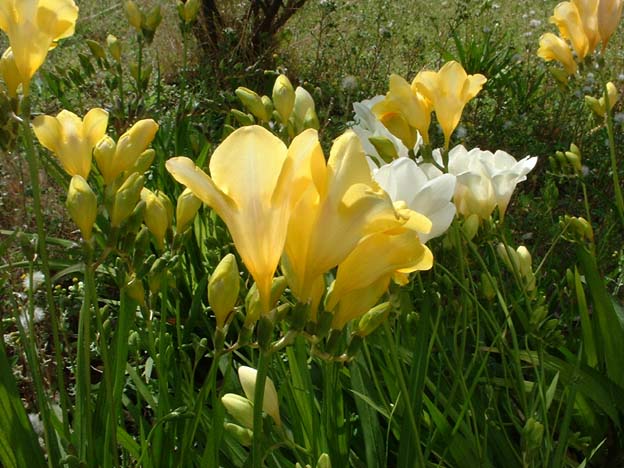There’s something instantly uplifting about freesia. Its elegant, arching stems, lined with trumpet-shaped blossoms, seem to dance in the breeze—each bloom releasing a sweet, citrusy fragrance that perfumes the air. A staple in floral arrangements, freesia is equally at home in borders, pots, and windowsills.
Celebrated for both beauty and scent, freesia captures the lightness of spring with a surprisingly refined presence. Though delicate in appearance, it brings color, joy, and aromatic richness wherever it grows.

Portrait of the Freesia
Freesia is a cormous perennial in the Iridaceae family, native to South Africa. Its blooms are arranged in a one-sided comb along the stem, often with vibrant shades ranging from yellow and white to purple and deep pink.
- Type: Tender perennial (commonly grown as annual)
- Family: Iridaceae
- Common Names: Freesia
Foliage and Form
Freesia’s narrow, sword-like leaves rise vertically from its base, providing a neat, grass-like backdrop for its arching flower stems. The overall structure is slender and graceful.
- Height: 30–45 cm (12–18 in)
- Spread: 15–20 cm (6–8 in)
- Growth Habit: Upright, clumping
Blooms and Fragrance
Each freesia stem produces several funnel-shaped flowers that open sequentially. Their color range is wide and often bi-colored, but their signature fragrance is what makes them iconic.
- Bloom Time: Late spring to early summer (earlier indoors)
- Color: White, yellow, pink, red, lavender, purple, bi-colored
- Fragrance: Strong, sweet, citrus-floral scent
The Right Time to Plant, Flower, and Prune Freesia
| Month | Planting | Flowering | Pruning |
|---|---|---|---|
| January | ✅ Indoors in pots | ❌ | ❌ |
| February | ✅ Indoors or frost-free | ❌ | ❌ |
| March | ✅ Outdoor (mild zones) | ❌ | ❌ |
| April | ✅ Most zones | ✅ (indoor/pot) | ❌ |
| May | ❌ | ✅ Outdoor bloom | ❌ |
| June | ❌ | ✅ Peak bloom | ✅ Deadheading |
| July | ❌ | ✅ Late bloom | ✅ Remove spent stems |
| August | ❌ | ✅ (cool climates) | ✅ Tidy up foliage |
| September | ❌ | ❌ | ✅ Dig & store corms |
| October | ✅ In warm climates | ❌ | ❌ |
| November | ✅ Indoors (next year) | ❌ | ❌ |
| December | ✅ Greenhouse only | ❌ | ❌ |
✅ = Recommended ❌ = Not advised
Watering, Sunlight, and Environment for Freesia
Watering
- Keep soil consistently moist but not soggy during active growth and blooming.
- Reduce watering once foliage starts to yellow and die back.
When to Water: Every 2–3 days in spring
How Much: Moderate, avoiding waterlogged conditions
Watch for: Rot in overly wet soil
Sunlight
- Freesias love bright sun but can tolerate partial shade, especially in hot climates.
- Indoors, place them near a south-facing window.
Ideal Exposure: 6+ hours of sunlight
Shade Tolerance: Partial, but bloom may reduce
Indoor vs Outdoor
- Freesias are excellent for pots, patios, and indoor forcing.
- In cooler climates, start them inside or grow entirely indoors in containers.
Best Location: Pots, borders, windowsills
Avoid: Exposed, frost-prone spots
Temperature
- Freesias thrive in mild temperatures and do not tolerate frost.
- Plant when soil is around 13–18°C (55–65°F).
Optimal Range: 10–22°C (50–72°F)
Hardiness Zones: USDA 9–10
Protection Tip: Lift corms before frost in cold zones
Ideal Soil Conditions for Growing Freesia
| Soil Feature | Optimal Condition | Why It Matters |
|---|---|---|
| Soil Type | Loose, sandy, well-aerated | Promotes drainage and easy root development |
| Texture | Fine, crumbly | Prevents water retention around sensitive corms |
| Drainage | Excellent | Reduces risk of root and corm rot |
| Moisture | Moist during growth, dry when dormant | Supports active bloom then allows rest |
| Soil pH | Slightly acidic to neutral (6.0–7.0) | Ideal for nutrient absorption |
| Fertility | Moderate with phosphorus | Enhances flower formation and color |
Common Problems & Solutions
| Issue 🐾 | Symptoms 🔍 | Solutions 🛠️ |
|---|---|---|
| Corm rot 💧 | Soft, mushy corms | Improve drainage, avoid overwatering |
| Weak flowering 🌱 | Tall foliage, few blooms | Provide more sun, add bloom fertilizer |
| Aphids 🐜 | Sticky leaves, curling stems | Use insecticidal soap or neem oil |
| Leaf yellowing 🍂 | Post-bloom dieback | Normal; reduce watering and lift corms if needed |
| Stunted growth 🐌 | Chewed leaves, poor stems | Check for slugs/snails; use copper or bait traps |
Freesia brings elegance and scent in equal measure. Whether cut for a vase or left to shine in a patio pot, its refined arching blooms and dreamy aroma make it a treasure for spring gardeners. With just a little care and planning, freesias will reward you with colorful clusters and unforgettable fragrance season after season.